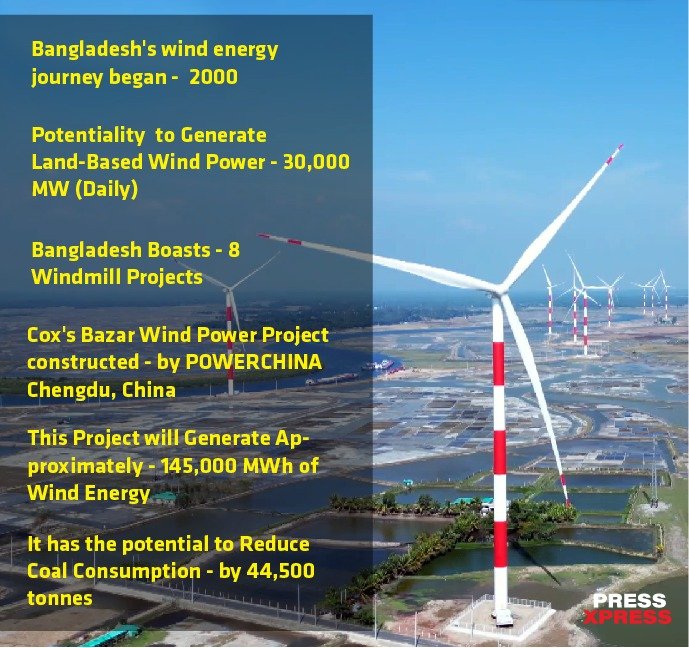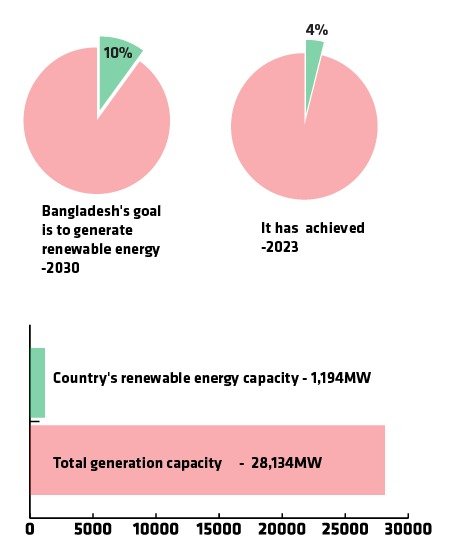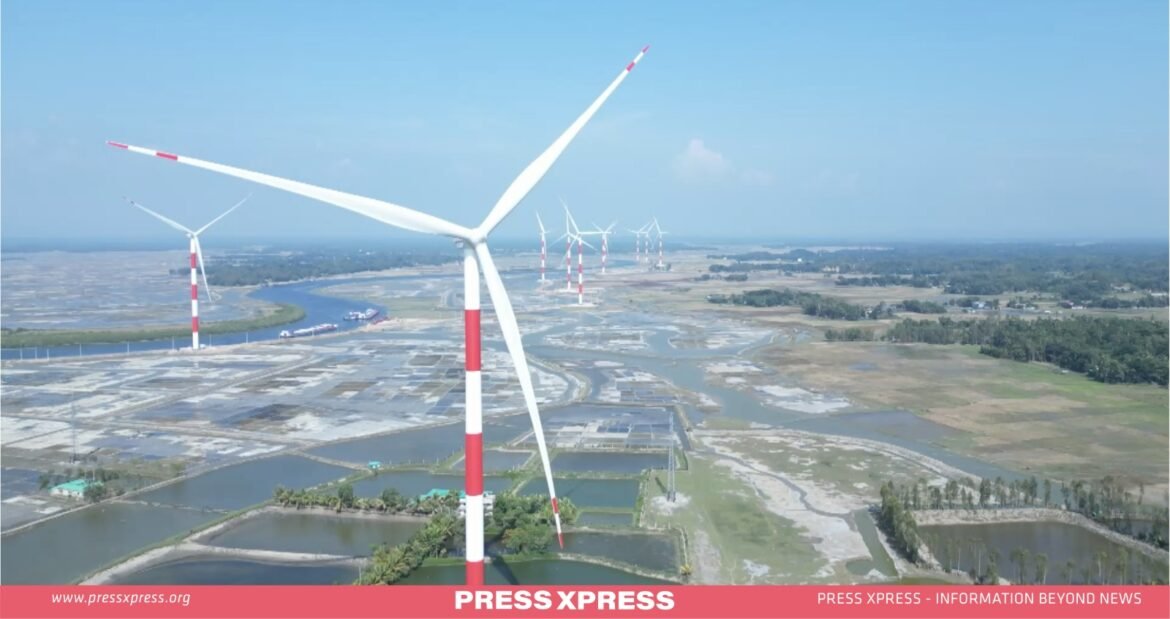In a significant stride towards sustainable energy solutions, the government of Bangladesh has given its nod to a groundbreaking joint venture with Denmark. The $1.3 billion project aims to develop a 500 MW wind power project along the picturesque coast of the Bay of Bengal. The project’s prospective site is located offshore of Cox’s Bazar district, offering a prime location with ample wind resources for the generation of clean energy.
Copenhagen Infrastructure Partners (CIP) and Copenhagen Offshore Partners (COP), in collaboration with Bangladesh’s Summit Group, jointly submitted the foreign direct investment (FDI) proposal in July. This consortium of global and local players is poised to make a significant impact on the energy sector.
You can also read: Denmark offers $1.3bn offshore wind power project in Bangladesh
Denmark’s outgoing ambassador, Winnie Estrup Petersen, presented the investment plan to Prime Minister Sheikh Hasina in July 2023. Subsequently, the project received approval for the initial phase of development, including site exclusivity for the next three years. Once put into action, this offshore wind project will mark a pioneering achievement not just within Bangladesh, but also with a higher likelihood throughout South Asia. Furthermore, the project will facilitate technology transfer, hastening the learning curve for an emerging industry and eliminating technological barriers to commencing similar projects.
According to the Institute for Energy Economics and Financial Analysis (IEEFA), the project has the potential to spark a new wave of foreign and domestic investments, steering Bangladesh toward a climate-prosperous future. The benefits extend beyond environmental concerns and include economic growth and job creation.
Bangladesh’s Wind Energy Journey
Bangladesh’s wind energy journey began in 2000, and a study report of BPDB’s suggests that the country has the potential to generate 30,000 MW of land-based wind power daily with wind speeds ranging from 5.75 to 7.75 meters per second. Wind power has the potential to be a competitive option for Bangladesh, with an estimated cost of $0.075 per kilowatt-hour. This figure is significantly lower than the costs associated with traditional energy sources like coal, LNG, and oil-fired power plants.
Currently, Bangladesh boasts eight windmill projects in various stages of completion, with a combined capacity of around 357 MW. These projects are essential for laying the groundwork for future renewable energy endeavors.

The inaugural energy project initiated by Chinese companies in Bangladesh, located in the southeast of the country, is now operational. The wind farm situated in Cox’s Bazar was constructed by POWERCHINA Chengdu, a subsidiary of the Power Construction Corporation of China. Boasting a total nominal power of 66 MW, this marks the nation’s first large-scale centralized wind power endeavor.This project will generate approximately 145,000 MWh of clean wind energy annually. In comparison to a traditional coal-fired power project, it has the potential to reduce coal consumption by 44,500 tonnes.
Its contribution will be significant in advancing Bangladesh’s economic growth, energy conservation, emissions reduction, and environmental protection.
Progress Towards Renewable Energy Targets
The transition of Bangladesh towards renewable energy sources, particularly solar power, is a response to growing concerns about climate change and environmental pollution. In line with its commitment to achieving Sustainable Development Goals (SDGs), the government actively supports renewable energy projects.

Bangladesh’s goal is to generate 10% of its power from renewable sources by 2030, but as of 2023, it has achieved only 4% of this target. Currently, the country’s renewable energy capacity is 1,194MW, out of a total generation capacity of 28,134MW, with solar energy playing a dominant role. Wind power projects are a relatively recent addition to Bangladesh’s energy landscape.
Bangladesh’s Clean Energy Journey and Ongoing Projects
Bangladesh is presently working on the development and evaluation of more than a dozen large-scale solar power plants, including three with a 1,000MW capacity each, to join the ranks of China, India, and the UAE in the gigawatt club. One of these three plants is currently in the construction phase on Swarna Dwip in Noakhali (formerly known as Jahazzair Char). In February of the previous year, Pacific Energy Group, LLC (Pacific Energy), a United States-based company, entered into a Joint Venture Agreement (JVA) with the Bangladesh Army Welfare Trust to undertake this project.
Since 2013, the 33rd Infantry Division of the Bangladesh Army has been responsible for the 370-square-kilometer island, where they have been implementing various development initiatives and establishing an exercise base.
In 2017, Bangladesh commenced the construction of an extensive solar facility that incorporates approximately five million solar panels. A 132-kilovolt, 35-kilometer-long power transmission line was erected to connect the generated electricity to the national grid, and substations, equipment, and inverters were installed, stretching from Teesta Ghat in Sundarganj to Rangpur. This remarkable 200 MW solar plant surpasses the 134.3 MW plant owned by Energon Renewables Ltd, a subsidiary of the Orion Group, in Mongla.
According to sources within the Energy Ministry, the government is currently either reviewing or implementing major projects in Sreemangal, Moulvibazar (300MW), Mongla, Bagerhat, and Thakurgaon (both 200MW).
State Minister for Energy and Power Nasrul Hamid reports that Bangladesh generates 1,194 MW from renewable sources, but only 825.23 MW is integrated into the national grid. Additionally, 1,262MW of renewable energy power plants are under construction through 30 projects, while 8,668MW of projects are in the planning phases.
Since 1996, Bangladesh has installed over six million Solar Home System (SHS) units, in addition to thousands of rooftop units, solar-powered street lighting and telecom BTS, and solar irrigation units. Furthermore, several private companies have established small solar power plants not connected to the grid, furthering the promotion of renewable energy.
Conclusion
Bangladesh’s wind energy journey is gaining momentum, with the country’s commitment to renewable energy aligning with its Sustainable Development Goals. As the nation continues to develop solar and wind power projects, it inches closer to its renewable energy targets. The ongoing projects and investments are paving the way for a cleaner, greener future, contributing to Bangladesh’s economic growth, energy conservation, emissions reduction, and environmental protection.


